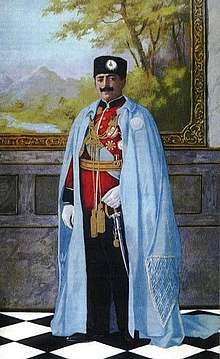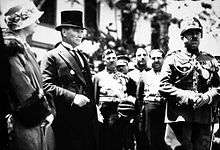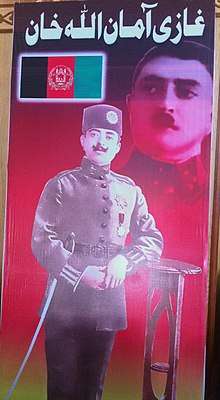Amanullah Khan
Amānullāh Khān (Pashto: امان الله خان) was the sovereign of the Kingdom of Afghanistan from 1919 to 1929, first as Emir and after 1926 as King.[1] After the Third Anglo-Afghan War, Afghanistan was able to relinquish from a protected state status to proclaim independence and pursue an independent foreign policy free from the influence of the British Raj.
| King Amanullah I غازي امان الله خان | |
|---|---|
| King of Afghanistan | |
 | |
| Sovereign Prince of Afghanistan | |
| Reign | 28 February 1919 – 9 June 1926 |
| Predecessor | Prince Nasrullah I |
| Successor | Himself (as King) |
| King of Afghanistan | |
| Reign | 9 June 1926 – 14 January 1929 |
| Predecessor | Himself (as Sovereign Prince) |
| Successor | King Inayatullah I |
| Born | 1 June 1892 Paghman, Principality of Afghanistan |
| Died | 25 April 1960 (aged 67) Zürich, Switzerland |
| Burial | |
| Spouse | Soraya Tarzi |
| Issue | See
|
| House | Barakzai |
| Father | Prince Habibullah I, Prince of Afghanistan |
| Mother | Sarwar Sultana Begum |
| Wikisource has original text related to this article: |
His rule was marked by dramatic political and social change, attempting to modernize Afghanistan on Western designs, which he did not fully succeed in, due to an uprising by Habibullah Kalakani and his followers. On 14 January 1929, Amanullah abdicated and fled to neighbouring British India as the Afghan Civil War began to escalate. From British India he went to Europe where after 30 years in exile, he died in Zürich, Switzerland, in 1960. His body was brought to Afghanistan and buried in Jalalabad.
Early years
Amanullah Khan was born on 1 June 1892, in Paghman near Kabul, Afghanistan. He was the third son of the Emir Habibullah Khan. Amanullah was installed as the governor of Kabul and was in control of the army and the treasury, and gained the allegiance of most of the tribal leaders.
Russia had recently undergone its Communist revolution, leading to strained relations between the country and the United Kingdom. Amanullah Khan recognized the opportunity to use the situation to gain Afghanistan's independence over its foreign affairs. He led a surprise attack against the British in India on 3 May 1919, beginning the Third Anglo-Afghan war. After initial successes, the war quickly became a stalemate as the United Kingdom was still dealing with the costs of World War I. An armistice was reached towards end of 1919, and Afghanistan was completely free of British diplomatic influence.

Reforms
Amanullah enjoyed early popularity within Afghanistan and he used his influence to modernise the country. Amanullah created new cosmopolitan schools for both boys and girls in the region and overturned centuries-old traditions such as strict dress codes for women. He increased trade with Europe and Asia. He also advanced a modernist constitution that incorporated equal rights and individual freedoms with the guidance of his father-in-law and Foreign Minister Mahmud Tarzi. His wife, Queen Soraya Tarzi played a huge role in regard to his policy towards women. This rapid modernisation created a backlash and a reactionary uprising known as the Khost rebellion which was suppressed in 1925. He also met with many Bahá'ís in India and Europe where he brought back books that are still to be found in the Kabul Library. This association later served as one of the accusations when he was overthrown.
At the time, Afghanistan's foreign policy was primarily concerned with the rivalry between the Soviet Union and the United Kingdom, the so-called Great Game. Each attempted to gain the favor of Afghanistan and foil attempts by the other power to gain influence in the region. This effect was inconsistent, but generally favourable for Afghanistan; Amanullah established a limited Afghan Air Force consisting of donated Soviet planes.
Visit to Europe


Amanullah travelled to Europe in late 1927. The Afghan King and Queen set out from Karachi and en route they met with King Fawad of Egypt in Cairo. They undertook a whirlwind European visit: Italy, arrival on 8 January 1928, where they met with King Victor-Emanuel III of Italy along with his Prime Minister, Benito Mussolini and Pope Pius XI in the Vatican City; France, arrival in Nice on 22 January 1928, in Paris on 25 January, meeting with President Doumergue; Belgium, arrival on Brussels on 8 February, meeting with King Albert I and Queen Elisabeth of Belgium. The next stop was Germany. The germanophile king arrived via Germany in Berlin on 22 February to meet President Paul von Hindenburg the same day. Next he travelled to Great Britain as guests of King George V and Queen Mary. The SS steam ship Maid of Orleans arrived in Dover on 13 March. The royal couple left England on 5 April to Poland. On their way, they had a longer stopover in Berlin where the Amir underwent an emergency tonsillectomy. The royal train with the Amir back on board arrived in the Polish border town of Zbąszyń on April, 28. The next day it pulled into Warsaw to be met by Polish ministers, the speaker of the Sejm and the country's president Ignacy Mościcki. At his request Amanullah was granted a possible audience with the First Marshal of Poland Józef Piłsudski. The Afghan party departed from Warsaw travelling east across the country to the border with the Soviet Union on 2 May 1928.[2]
Civil War
During Amanullah's visit to Europe, opposition to his rule increased to the point that an uprising in Jalalabad culminated in a march to the capital, and much of the army deserted rather than resist. In January 1929, Amanullah abdicated and went into temporary exile in then British India. His brother Inayatullah Khan became the next king of Afghanistan for a few days until Habibullah Kalakani, a leader of the "Saqqawists" opposition movement, took over. While in India, Kalakani battled anti-Saqqawist tribes. Around 22 March, Amanullah returned to Afghanistan assembling forces in Kandahar to reach Kabul and dispose of Kalakani. However his forces failed to advance and on 23 May 1929 he fled to India again, this time never to return back to his country.[3]
Exile
Kalakani's nine months rule was soon replaced by Nadir Khan on 13 October 1929. Amanullah Khan attempted to return to Afghanistan, but he had little support from the people. From British India, the ex-king traveled to Europe and settled in Italy, buying a villa in Rome's Prati neighborhood. Meanwhile, Nadir Khan made sure his return to Afghanistan was impossible by engaging in propaganda. Most of his reforms had been reversed, but the later King, Mohammad Zahir Shah, made a more gradual program of reform.[4]
Nevertheless, he still had a group of staunch supporters in Afghanistan. These Amanullah loyalists unsuccessfully attempted several times in the 1930s and 1940s to bring him back to power.
In 1941, some press in the west reported that Amanullah was now working as an agent for Nazi Germany in Berlin.[5] It is believed he was involved in plans to regain his throne with Axis help,[6] despite Afghanistan's neutrality. However following the Axis loss in Stalingrad in 1943, the plans cooled off and were never executed.[7]
Death

Amanullah Khan died in Zürich, Switzerland, in 1960. His body was brought to Afghanistan and buried in the eastern city of Jalalabad. He left behind his widowed wife and four sons and five daughters, including Princess India of Afghanistan.[8]
Foreign honours
.svg.png)
.svg.png)


.svg.png)





See also
- History of Afghanistan
- Reforms of Amānullāh Khān and civil war
- Lycées Esteqlal and Malalaï in Kabul
References
- Poullada, L. B. "AMĀNALLĀH". Encyclopædia Iranica (Online ed.). United States: Columbia University.
- Paraskiewicz, Kinga (2014). Historyczna wizyta Amanullaha Chana króla Afganistanu w Europie (1927–1928) (The Historic visit of Amanullah Khan, King of Afghanistan, in Europe /1927-78/) (in Polish). Księgarnia Akademicka. pp. 29–71. ISBN 978-83-7638-532-7.; source of information on the route and the particular dates of visits to various countries
- https://books.google.com/books?id=UCtpAwAAQBAJ&pg=PT140
- The Politics of State Intervention: Gender Politics in Pakistan, Afghanistan, and Iran by Shireen Burki
- https://trove.nla.gov.au/newspaper/article/8180382
- https://www.nytimes.com/1979/04/29/archives/afghan-king-in-rome-exile-tightens-belt-daud-sent-money-to-family.html
- Crews, Robert D. (14 September 2015). Afghan Modern: The History of a Global Nation. ISBN 9780674286092.
- https://www.tolonews.com/afghanistan/ex-king-amanullah-khans-son-passes-away
- https://www.flickr.com/photos/8637723@N05/6797502735/
- http://www.afghanfun.com/gallery/old/king_amanullah/pages/10_jpg.htm
- AAS 20 (1928), n. 3, p. 93.
- http://media.gettyimages.com/photos/le-roi-dafghanistan-amanullah-khan-le-27-mai-1919-picture-id558660113
- https://www.britannica.com/biography/Amanullah-Khan/images-videos/Amanullah-Khan-1928/8330
External links
| Wikimedia Commons has media related to Amanullah Khan. |
- Amanulla Khan: Betrayal of Nadir Khan
- Ghazi Amanullah Khan City next to Jalalabad
- Ghazi Amanullah Khan City on YouTube
- Newspaper clippings about Amanullah Khan in the 20th Century Press Archives of the ZBW
Amanullah Khan Barakzai Dynasty Born: 01 June 1892 Died: 25 April 1960 | ||
| Regnal titles | ||
|---|---|---|
| Preceded by Habibullah Khan |
Emir of Afghanistan 1919–1926 |
Succeeded by Himself King of Afghanistan |
| Preceded by Himself Emir of Afghanistan |
King of Afghanistan 1926–1929 |
Succeeded by Inayatullah Khan |
